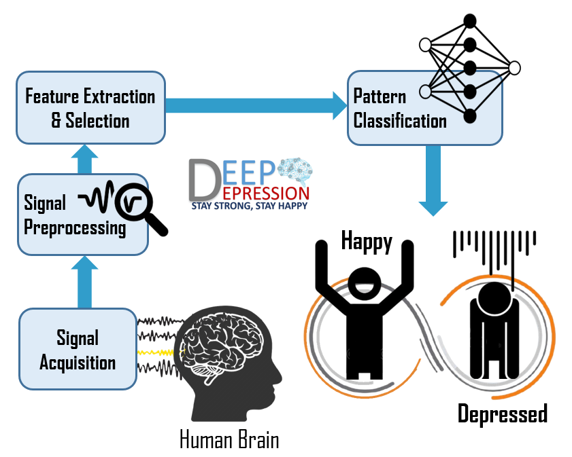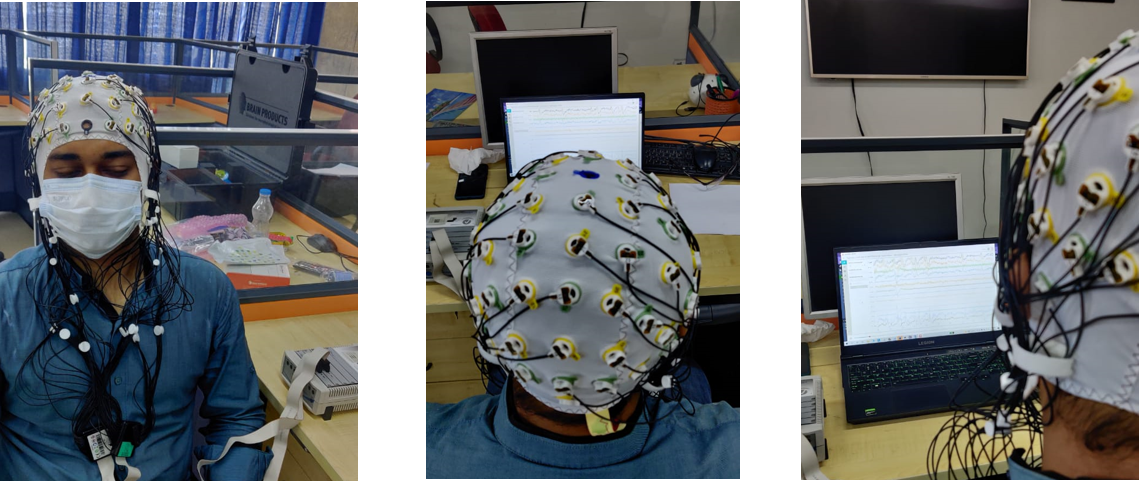Deep Depression
BCI Based System for Identifying Depression through Neural Connectivity Analysis


Depression is a prevalent mental illness impacting millions globally each year, projected to become a major cause of devastating disease by 2022. According to the World Mental Health Survey, around 3000 suicides and 60,000 attempted suicides occur daily, with these figures worsening during the COVID-19 pandemic. The current diagnostic process, relying on clinical questionnaires and behavioral observation, is time-consuming. To address this, a multidisciplinary team is developing a Brain-Computer Interface (BCI) technology to analyze brain signals and identify depression biomarkers. This innovative system offers a more efficient, painless, and patient-friendly diagnostic tool, aiming to reduce depression-related fatalities and improve overall well-being.
Specifications
- Clinical Intervention
- Whether a person has depression or not.
- Can get to know the severity of his depression.
- Can get to know about his depression without interrogating them.
- Can save more lives from the hell of suicide.
Diagrams


Publications
A. Dev et al., "Exploration of EEG-Based Depression Biomarkers Identification Techniques and Their Applications: A Systematic Review," in IEEE Access, vol. 10, pp. 16756-16781, 2022, doi: 10.1109/ACCESS.2022.3146711 Published in: IEEE Access ( Volume: 10) Page(s): 16756 - 16781 Date of Publication: 26 January 2022 Electronic ISSN: 2169-3536 DOI: 10.1109/ACCESS.2022.3146711 Publisher: IEEE
Abstract
Depression is the most common mental illness, which has become the major cause of fear and suicidal mortality or tendencies. Currently, about 10% of the world population has been suffering from depression. The classical approach for detecting depression relies on the clinical questionnaire, which depends on the patients’ responses as well as observing their behavioral activities. However, there is no established method to detect depression from EEG biomarkers. Therefore, exploration of EEG biomarkers for depression assessments is vital and has a great potential to improve our understanding and clinical interventions. In this study, we have conducted a systematic review of 52 research articles using the PRISMA-P systematic review protocol, where we analyzed their research methodologies and outcomes. We categorized the experimentations in these articles according to their physical and psychological aspects scaled by the commonly used clinical questionnaire-based assessments. This study finds that the negative stimuli are the better identification strategies for evaluating depression through EEG signals. From this exploration, researchers observed that the Neural Connectivity Analysis and Brain Topological Mapping have huge potentials for finding depression biomarkers, and it is evident that the right-side hemisphere and frontal and parietal-occipital cortex are distinct regions to detect depression using EEG signals. For this mechanism, researchers are using many signal processing and machine learning approaches. In the case of filtering, Independent Component Analysis (ICA) is commonly used to eliminate physiological and non-physiological artifacts. Among machine learning approaches, Convolutional Neural Network (CNN) and Support Vector Machine (SVM) showed better performance for classifying healthy and depressed brains. The authors hope this study will create an opportunity to explore more in the future for EEG as a diagnostic tool by analyzing brain functional connectivity for focusing on clinical interventions.
Islam, M. S., Mamun, K. A., & Deng, H. (2017). Decoding of Human Movements Based on Deep Brain Local Field Potentials Using Ensemble Neural Networks. Computational Intelligence and Neuroscience, 2017, 5151895. https://doi.org/10.1155/2017/5151895
Abstract
Decoding neural activities related to voluntary and involuntary movements is fundamental to understanding human brain motor circuits and neuromotor disorders and can lead to the development of neuromotor prosthetic devices for neurorehabilitation. This study explores using recorded deep brain local field potentials (LFPs) for robust movement decoding of Parkinson’s disease (PD) and Dystonia patients. The LFP data from voluntary movement activities such as left and right hand index finger clicking were recorded from patients who underwent surgeries for implantation of deep brain stimulation electrodes. Movement-related LFP signal features were extracted by computing instantaneous power related to motor response in different neural frequency bands. An innovative neural network ensemble classifier has been proposed and developed for accurate prediction of finger movement and its forthcoming laterality. The ensemble classifier contains three base neural network classifiers, namely, feedforward, radial basis, and probabilistic neural networks. The majority voting rule is used to fuse the decisions of the three base classifiers to generate the final decision of the ensemble classifier. The overall decoding performance reaches a level of agreement (kappa value) at about for decoding movement from the resting state and about for decoding left and right visually cued movements
Partners









